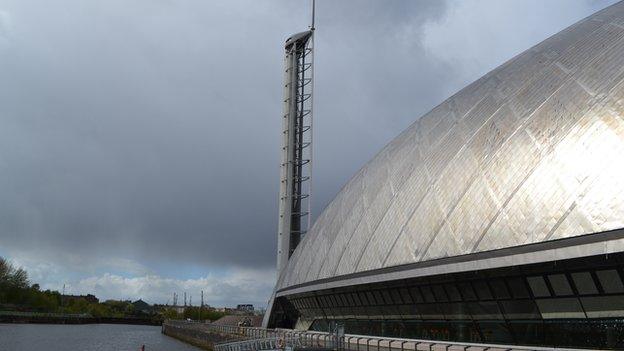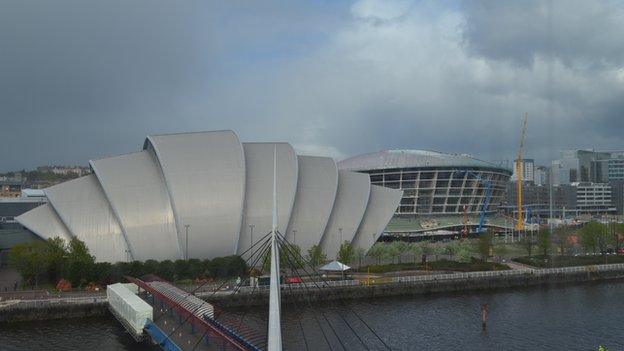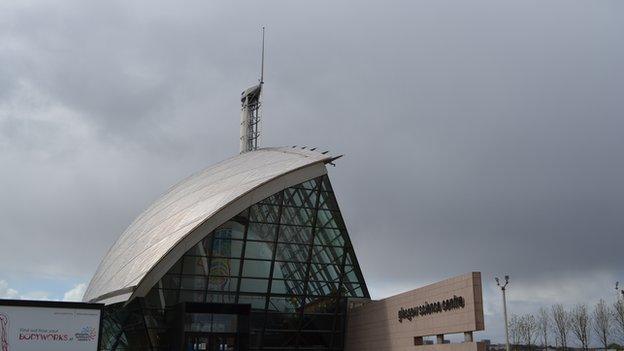Faulty tower: Glasgow's £10m white elephant
- Published

It is the tallest fully-rotating tower in the world but it does not work
The Glasgow Science Centre tower was supposed to be the city's answer to the Eiffel Tower. But instead it became an expensive white elephant, which has been riddled with problems and shut for more than 80% of its life.
When it was built, it held the Guinness World Record for the "tallest fully-rotating tower" - although to be fair, there was not much competition for that particular accolade.
The 127m-tall (416 ft) steel and glass tower, the highest building in Scotland, was the only structure in the world able to rotate fully through 360 degrees from base to top.
Neil Baxter, secretary of the Royal Incorporation of Architects in Scotland says the idea was unique: "Nobody had ever tried to do that."
He says: "None of us knew that the mechanism would not work.
"All of us were working on the optimistic basis that 'here's a really bold idea, obviously the engineers have tested it'."
But the £10m tower has been plagued by problems from the start. It missed its opening day in June 2001, as well as the visit of the Queen to the science centre a few weeks later.
When it did finally open, it was found the glass elevators were too heavy, causing the mechanism to overheat.
Then it closed for two-and-a-half years because one of the ball bearings which took the weight of the whole structure had sunk.
To fix the problem the whole tower had to be lifted on to temporary supports.
Mr Baxter says there was a real concern that the tower could topple over.
He says: "You had the potential prospect of ruining not just the tower, but also causing some pretty substantial damage to the science centre."
The ball-bearing problem continued to dog the tower throughout the decade, with numerous lengthy closures.
But one of the most dramatic incidents came during a rare period of operation in January 2005.

The tower was "never meant to be built"
Ten people, including four children, were trapped for five hours after a cable carrying their lift snapped and the emergency brakes were triggered.
The group were stuck in the glass lift about 150ft up while fire crews worked out how to rescue them, eventually cutting through panels in the tower.
The tower has now been closed since August 2010 and the science centre recently announced it had settled a lengthy court action with the contractors.
Science centre bosses said they had received "substantial" compensation but there seems to be very little prospect of the tower ever turning again.
Architect Peter Wilson, of Edinburgh Napier University, is one of the critics of the project.
"The fundamental thing about this is that when it was initially designed, it was never meant to be built," he says.
"It was intended for an 'ideas' competition."
The original design was submitted by renowned architect Richard Horden for a competition in 1992, which was looking for "big imaginative ideas" for a space at St Enoch Square in the city centre.
Instead of rotating in the breeze in the centre of Glasgow, the powers-that-be decided it would be the perfect design to go alongside the developments which were taking place on former docklands on the south of the river Clyde in Govan.

The tower is across the river from the Armadillo and the Hydro arena, which is currently under construction
Norman Foster's "Armadillo" extension to the Scottish Exhibition and Conference Centre was taking shape on the north bank of the river and Peter Wilson says the decision to build the tower was Glasgow "grandstanding as usual".
Prof Horden severed his links in 1999 when his firm were removed in a dispute over time and cost.
He says it is "always sad to reflect on this project".
Prof Horden adds it was "entirely possible for the initial design to have functioned successfully".
But he says it failed because of poor management decisions, such as removing the original "first-class design team" and "doing it on the cheap".
John Glenday, editor of Scottish architecture website Urban Realm, believes the tower was "too ambitious" and it may have been a "legacy from the froth of the Millennium".
"Instead of being a feather in Glasgow's cap it has become an albatross around its neck," he says.

The Glasgow Science Centre has been a major tourist attraction
The idea was that the tower would preserve its stability by turning into the prevailing wind on a huge bearing which carried its 460-tonne vertical load.
Mr Baxter says: "It was a very tall order and ultimately it did not work out because the compression-loading of the tower was too great for the very large ball bearings they were using.
"Effectively while it presumably it worked in theory and in computer models, in reality it didn't work."
The science centre claims 65,000 people have been to the top of the tower, which works out at about £150 per person, without taking into account operating costs and maintenance.
"If you work out the equation of tower capacity against cost it must be the most expensive tower on the planet," Mr Baxter says.
Scottish National Party MSP Sandra White says people were "pretty deflated" when the tower did not work.
"I've been down there and I do still find tourists asking if they can go up the tower," she says.
Ms White praised the new science centre chief executive Stephen Breslin for bringing the legal action to a conclusion.
Mr Breslin says: "We have settled the outstanding litigation with contractors Carillion and that is public record. There is no outstanding litigation. This means we can now concentrate on a solution.
"We have commissioned some engineers to put together a fairly detailed design and costing for reopening the tower. But I will only commit money if we have a workable solution.
"Given the tower's history, we can't afford to get it wrong again."
- Published28 July 2011